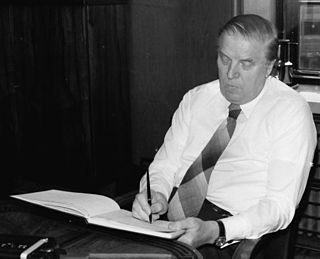
The Centre Party of Finland is a centrist, liberal, agrarian political party in Finland.

Karl-August Fagerholm was Speaker of Parliament and three times Prime Minister of Finland. Fagerholm became one of the leading politicians of the Social Democrats after the armistice in the Continuation War. As a Scandinavia-oriented Swedish-speaking Finn, he was believed to be more to the taste of the Soviet Union's leadership than his predecessor Väinö Tanner. Fagerholm's post-war career was however marked by fierce opposition from both the Kremlin and domestic communists. He narrowly lost the presidential election to Urho Kekkonen in 1956.

Keijo Antero Liinamaa was a lawyer and caretaker Prime Minister of Finland.

Finnish Centre Youth Finnish: Keskustanuoret is the biggest political youth organisation in Finland with 17 000 members. It is the youth wing of the Centre Party. It is formed by 19 regional organisations and approximately 400 local associations.
Parliamentary elections were held in Finland on 6 and 7 July 1958. The communist Finnish People's Democratic League emerged as the largest party, but was unable to form a government.
Parliamentary elections were held in Finland on 1 and 2 July 1948.
Parliamentary elections were held in Finland on 1 and 2 July 1951.
Parliamentary elections were held in Finland on 7 and 8 March 1954.
Parliamentary elections were held in Finland on 4 and 5 February 1962.
Parliamentary elections were held in Finland on 20 and 21 March 1966. The Social Democratic Party (SDP) overtook the Centre Party as the largest faction in Parliament. Rafael Paasio of the SDP subsequently became Prime Minister and formed a popular front government consisting of the SDP, the Centre Party, the People's Democratic League (SKDL), and the Social Democratic Union of Workers and Smallholders (TPSL) in May 1966.
Parliamentary elections were held in Finland on 15 and 16 March 1970.
Parliamentary elections were held in Finland on 2 and 3 January 1972.
Parliamentary elections were held in Finland on 18 and 19 March 1979.

Eino Oskari Uusitalo was a Finnish politician from the Centre Party. He was born in Soini.
The Centrism, is a centrist anti-communist coalition of four Italian political parties that formed governments throughout the 1940s and the late 1950s. This period is known as "The Years of Centrism". The founder of this coalition was Alcide De Gasperi, Christian Democratic leader and Prime Minister of Italy. Another key figures of the Centrist coalition was the Liberal Luigi Einaudi, who was elected President of Italy in 1948 and remained in office until 1955.
The Night Frost Crisis or the Night Frost was a political crisis that occurred in Soviet-Finnish relations in the autumn of 1958. It arose from Soviet dissatisfaction with Finnish domestic policy and in particular with the composition of the third government to be formed under Prime Minister Karl-August Fagerholm. As a result of the crisis, the Soviet Union withdrew its ambassador from Helsinki and put pressure on the Finnish government to resign. The crisis was given its name by Nikita Khrushchev, who declared that relations between the countries had become subject to a "night frost".
















